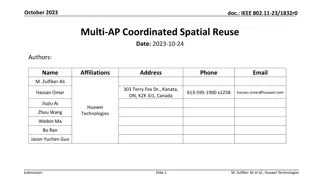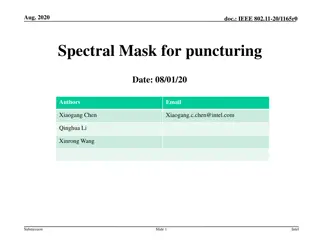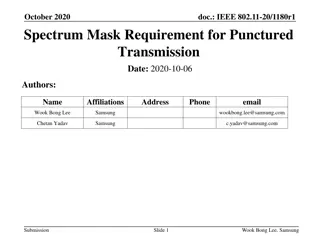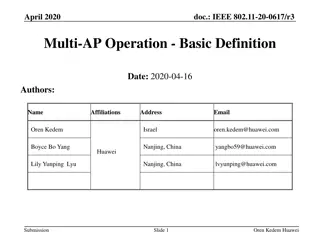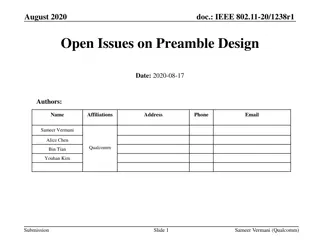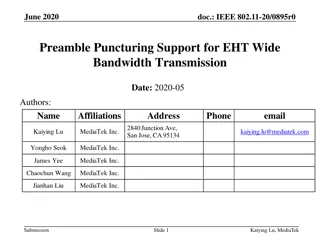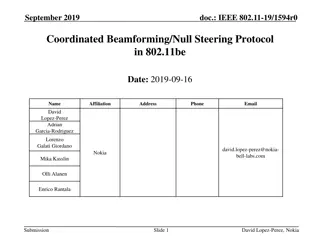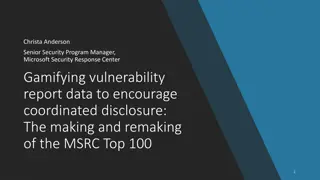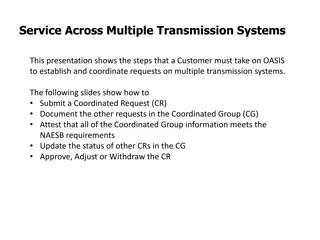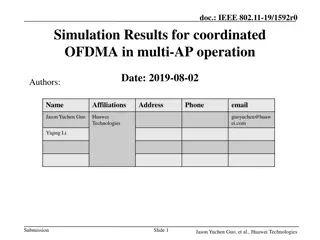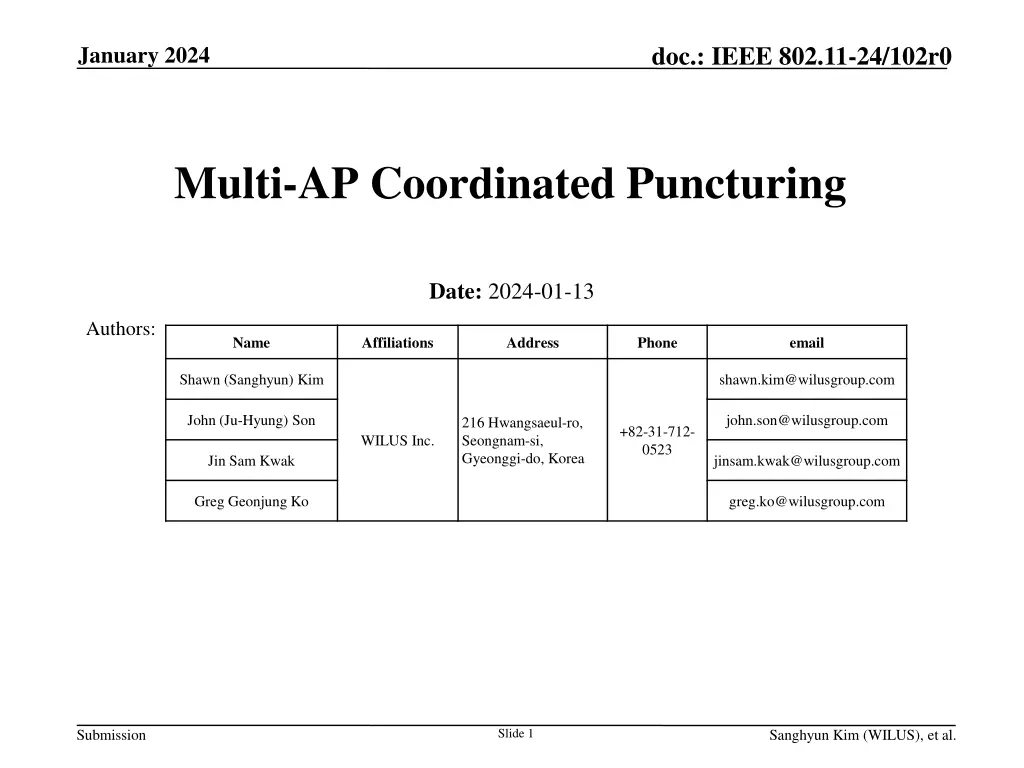
Multi-AP Coordinated Puncturing: Enhancing Wireless Communication Efficiency
Explore the advantages of Multi-AP Coordinated Puncturing in IEEE 802.11 networks in our detailed study. This innovative approach minimizes contention, optimizes resource sharing, and improves overall system performance by coordinating subchannel usage among access points. Learn about the benefits and implementation of this groundbreaking solution for wireless communication environments.
Download Presentation

Please find below an Image/Link to download the presentation.
The content on the website is provided AS IS for your information and personal use only. It may not be sold, licensed, or shared on other websites without obtaining consent from the author. If you encounter any issues during the download, it is possible that the publisher has removed the file from their server.
You are allowed to download the files provided on this website for personal or commercial use, subject to the condition that they are used lawfully. All files are the property of their respective owners.
The content on the website is provided AS IS for your information and personal use only. It may not be sold, licensed, or shared on other websites without obtaining consent from the author.
E N D
Presentation Transcript
doc.: IEEE 802.11-24/102r0 January 2024 Multi-AP Coordinated Puncturing Date: 2024-01-13 Authors: Name Affiliations Address Phone email Shawn (Sanghyun) Kim shawn.kim@wilusgroup.com John (Ju-Hyung) Son john.son@wilusgroup.com 216 Hwangsaeul-ro, Seongnam-si, Gyeonggi-do, Korea +82-31-712- 0523 WILUS Inc. Jin Sam Kwak jinsam.kwak@wilusgroup.com Greg Geonjung Ko greg.ko@wilusgroup.com Slide 1 Submission Sanghyun Kim (WILUS), et al.
doc.: IEEE 802.11-24/102r0 January 2024 Abstract Many contributions have been submitted on M-AP coordination features; Coordinated resource sharing [1][2] Coordinated spatial reuse [3][4] Coordinated R-TWT [5-10] Coordinated transmission [11-13] Each M-AP feature requires a different level of coordination among APs We can consider coordination schemes with a long coordination cycle and infrequent information exchange among APs as low-level M-AP coordination schemes In this contribution, we propose multi-AP coordinated puncturing which requires low-level of coordination among APs Slide 2 Submission Sanghyun Kim (WILUS), et al.
doc.: IEEE 802.11-24/102r0 January 2024 Recap: Preamble Puncturing Disabled Subchannel is defined in EHT 35.15.2 Preamble puncturing operation (11be D5.0) AP can disable (static puncturing) any subchannel(s) of the BSS by including Disabled Subchannel Bitmap in the EHT Operation element The AP sets a bit in the bitmap to 1 to indicate that the corresponding subchannel as a punctured subchannel of its BSS Then, associated STAs of the BSS set the TXVECTOR parameter INACTIVE_SUBCHANNELS of an HE, EHT, or non-HT duplicate PPDU based on the value indicated by the subfield Slide 3 Submission Sanghyun Kim (WILUS), et al.
doc.: IEEE 802.11-24/102r0 January 2024 Proposed solution M-AP Coordinated Puncturing Coordinating APs exchange operating channel information e.g., Primary channel, minimum required BW, etc. Then each AP can set subchannel(s) overlapped with primary channel of the other BSS(s) as disabled (punctured) subchannel(s) for its BSS LL traffic Ch_4 Frame exchanges Punctured Ch_3 (disabled) Disabled Subchannel @BSS1 Ch_2 Frame exchanges Frame exchanges Beacon Frame exchanges Ch_1 (P_20) AP1 (Disabling Ch_3) P_20 info. Ch_4 Ch_1 Ch_3 Frame exchanges Beacon Ch_3 (P_20) Frame exchanges Frame exchanges (Disabling Ch_1) Ch_2 Disabled Subchannel @BSS2 Punctured Ch_1 (disabled) AP2 LL traffic Slide 4 Submission Sanghyun Kim (WILUS), et al.
doc.: IEEE 802.11-24/102r0 January 2024 M-AP Coordinated Puncturing Benefits Reducing contentions from OBSS on each BSS s primary channel Allow in-time transmission of Low Latency (LL) traffic Discussions (details in the following pages) Under utilization of disabled subchannel(s) When BSSs have the same primary channel Relationship with non-primary channel access [14][15][16] Limited overheads Long Coordination Cycle After initial coordination, the next coordination would occur only when one of the APs change its primary channel Small amount of information for coordination Primary channel and required minimum BW to be exchanged No new operations defined for Non-AP STAs Non-AP STAs follow the EHT s disabled subchannel operations Slide 5 Submission Sanghyun Kim (WILUS), et al.
doc.: IEEE 802.11-24/102r0 January 2024 Discussions (1) Consistently puncturing my BSS subchannel(s) for neighbor BSS may lead to channel under utilization ? We can consider to apply puncturing only during a specific time period (e.g., R-TWT SP of the neighbor BSS) R-TWT SP of AP1 R-TWT SP of AP2 AP1 doesn t occupy P20 of AP2 during R-TWT SP of AP2 Ch_4 Disabled Subchannel @BSS1 Ch_3 (disabled) Frame exchanges Frame exchanges (temporal) Ch_2 Frame exchanges Frame exchanges Ch_1 (P_20) AP1 P_20 info. & R-TWT SP info. Ch_4 Ch_1 Ch_3 Frame exchanges Frame exchanges Ch_3 (P_20) Frame exchanges Frame exchanges Ch_2 Disabled Subchannel @BSS2 Ch_1 (disabled) AP2 (temporal) AP2 doesn t occupy P20 of AP1 during R-TWT SP of AP1 Slide 6 Submission Sanghyun Kim (WILUS), et al.
doc.: IEEE 802.11-24/102r0 January 2024 Discussions (2) Multi-AP coordination can only be applied to BSSs using different Primary channels? During the Multi-AP coordination procedure, one of the AP may consider changing its Primary channel to utilize M-AP coordinated puncturing. If two BSSs share the same primary channel and Non-Primary Channel Access is allowed, puncturing subchannels matching to a neighbor BSS alternative primary channel (S20 in the example below) would be helpful TXOP of AP1 DL PPDU BA DL PPDU BA 40 MHz DL PPDU 40 MHz DL PPDU 80+40 MHz PPDU (S20 of AP2 is punctured) BA BA S20 of AP2 BA BA DL PPDU DL PPDU AP1 P20 of AP2 P20 40 MHz DL PPDU 40 MHz DL PPDU BA BA S20 S20: Subchannel for non-primary channel access AP2 S20 info. non-primary channel access mode (Busy_OBSS TXOP) P20 Slide 7 Submission Sanghyun Kim (WILUS), et al.
doc.: IEEE 802.11-24/102r0 January 2024 Summary In this submission, the Multi-AP Coordinated Puncturing scheme is proposed to reduce contentions from OBSS on each BSS s primary channel, which allows in-time transmission of Low Latency (LL) traffic. Slide 8 Submission Sanghyun Kim (WILUS), et al.
doc.: IEEE 802.11-24/102r0 January 2024 Straw Poll 1 Do you agree that an AP may set disabled subchannel for its BSS based on the primary channel of a neighboring BSS? Slide 9 Submission Sanghyun Kim (WILUS), et al.
doc.: IEEE 802.11-24/102r0 January 2024 Straw Poll 2 Do you agree to define mechanism(s) where an AP coordinates disabled subchannel(s) of its BSS with neighboring AP(s)? Disabled subchannel(s) refers subchannel(s) punctured for the BSS. The detail is TBD. Slide 10 Submission Sanghyun Kim (WILUS), et al.
doc.: IEEE 802.11-24/102r0 January 2024 Reference [1] 11-23/41 [2] 11-23/768 [3] 11-23/1037 [4] 11-23/325 [5] 11-23/226 [6] 11-23/250 [7] 11-23/291 [8] 11-23/293 [9] 11-23/297 [10] 11-23/771 [11] 11-22/1821 [12] 11-23/243 [13] 11-23/1176 Considerations on Coordinated TDMA (Yanjun Sun) Discussion on C-OFDMA operation (Jinyoung Chun) Performance of Coordinated Spatial Reuse (Kanke Wu) Coordinated Spatial Reuse for UHR (Jason Yuchen Guo) Coordination of R-TWT for Multi-AP Deployment (Abdel Karim) AP coordination with R-TWT (Liwen Chu) R-TWT Multi-AP Coordination (Muhammad Kumail Haider) Follow-up on TWT-based Multi-AP Coordination (Rubayet Shafin) rTWT for Multi-AP (Laurent Cariou) Coordinated R-TWT Protection in Multi-BSS (SunHee Baek) System Level Simulation of Co-BF and Joint Tx (Kosuke Aio) Joint Transmission for UHR - Additional Results (Ron Porat) Multi-AP Simulations: framework and Joint Transmission results (Rainer Strobel) Non-primary channel access (Yongho Seok) UHR secondary channel access (Minyoung Park) Discussions on Non-primary Channel Access (Sanghyun Kim) [14] 11-23/797 [15] 11-23/961 [16] 11-23/1365 Slide 11 Submission Sanghyun Kim (WILUS), et al.

